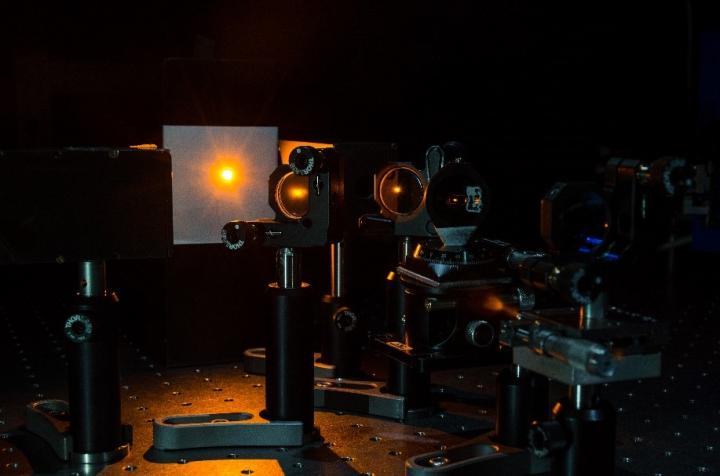Researchers use frequency conversion to create a more practical, high-power femtosecond yellow laser

Credit: Varun Sharma
WASHINGTON — Researchers have developed a new compact and ultrafast, high-power yellow laser. The tunable laser exhibits excellent beam quality and helps fill the need for a practical yellow light source emitting ultrafast pulses of light.
“The yellow-orange spectral range is highly absorbed by hemoglobin in the blood, making lasers with these wavelengths particularly useful for biomedical applications, dermatology treatments and eye surgery,” said research team member Anirban Ghosh from the Photonic Sciences Lab at the Physical Research Laboratory in India. “A femtosecond, tunable yellow laser source might one day offer medical treatments that produce less thermal damage and are more selective.”
In The Optical Society (OSA) journal Optics Letters, researchers led by Goutam K. Samanta describe how they used an optical phenomenon known as nonlinear frequency conversion to convert mid-infrared laser light into yellow light that can be tuned from 570 nm to 596 nm.
“We demonstrate a robust, high-power, ultrafast, tunable yellow radiation in a rather simple experimental configuration,” said Ghosh. “In addition to biomedical applications, this is a sought-after wavelength range for full-color video projection and could be used for a variety of spectral applications.”
Building a better yellow laser
Although studies have shown that laser emitting in the yellow spectral range are optimal for various medical treatments, such wavelengths are usually created using bulky and inefficient copper vapor lasers, dye lasers and optical parametric oscillators. These sources have been used successfully for various applications, but they suffer from one or more drawbacks such as low average power, lack of good spatial beam profile, limited or no wavelength tunability and broad output pulses.
“Femtosecond lasers are important for many applications because they emit a large number of photons in a short period to provide a very high intensity and extremely high precision without causing any thermal damage,” said Ghosh. “However, there is no commercially available femtosecond yellow laser that can provide all the desired parameters needed for the applications that would benefit from this wavelength range.”
To address these limitations in a single experimental configuration, the researchers used a recently developed ultrafast solid-state Cr2+:ZnS laser emitting in the mid-infrared range along with a two-stage frequency-doubling process. Frequency doubling an ultrafast laser is not an easy process and requires identifying the right crystal to produce a quality laser output with the desired properties.
“We frequency-doubled the ultrafast mid-infrared laser with a peak wavelength at 2360 nm in two different nonlinear crystals and used simple optical components available in any standard optics laboratory to achieve high power, tunable, ultrafast yellow laser source,” said Ghosh. “As a byproduct, our source provides tunable ultrafast near-infrared radiation with substantial average power useful for various fields, including spectroscopy, material processing and imaging.”
Tests of the new laser showed that it can provide a maximum output average power over 1 W with 130 femtosecond pulses at a repetition rate of 80 MHz with an outstanding spatial beam profile. The researchers also observed excellent power stability over a long duration.
The researchers plan to further improve the laser’s pulse duration, efficiency and compactness. They are also working to optimize the laser so that it can operate at room temperature to make it more practical for long-term use.
###
Paper: D. Yadav, A. Ghosh, R. K. Saripalli, G. K. Samanta, “Watt-level, ultrafast, tunable yellow source based on single-pass, fourth harmonic generation of Cr2+:ZnS laser at 2360 nm,” Opt. Lett., 45, 18, 5109-5112 (2020).
DOI: https:/
About Optics Letters
Optics Letters offers rapid dissemination of new results in all areas of optical science with short, original, peer-reviewed communications. Optics Letters accepts papers that are noteworthy to a substantial part of the optics community. Published by The Optical Society and led by Editor-in-Chief Miguel Alonso, Institut Fresnel, École Centrale de Marseille and Aix-Marseille Université, France, University of Rochester, USA. Optics Letters is available online at OSA Publishing.
About The Optical Society
Founded in 1916, The Optical Society (OSA) is the leading professional organization for scientists, engineers, students and business leaders who fuel discoveries, shape real-life applications and accelerate achievements in the science of light. Through world-renowned publications, meetings and membership initiatives, OSA provides quality research, inspired interactions and dedicated resources for its extensive global network of optics and photonics experts. For more information, visit osa.org.
Media Contact:
Media Contact
James Merrick
[email protected]
Original Source
https:/
Related Journal Article
http://dx.




